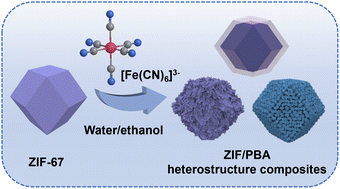Zeolitic imidazolate frameworks (ZIFs) and Prussian blue analogues (PBAs) are regarded as a subfamily of MOFs and possess great electrochemical characteristics, which are widely employed in energy and environmental applications. Benefiting from the merits of these two MOFs, we report a simple ion-exchange method to prepare ZIF-67/PBA heterostructure composites (abbreviated as ZP composites) with ZIF-67 and PBA as precursors. After low-temperature calcination, the structure converted into bimetallic N-doped dodecahedra that retained the structures of the ZP composites. The as-prepared ZP composites were utilized as electrode materials for supercapacitors that exhibited great rate capability and cycling stability. Furthermore, we assembled an asymmetric supercapacitor device with ZP composites and activated carbon. These results demonstrated that dual-MOF heterostructure composites showed great potential when applied as electrode materials.
